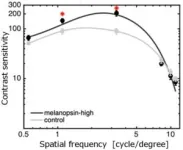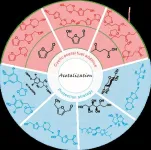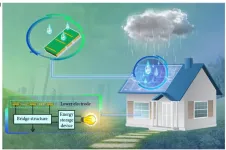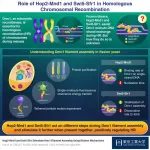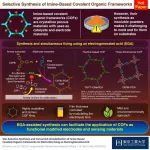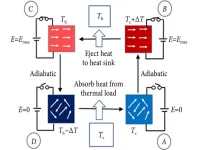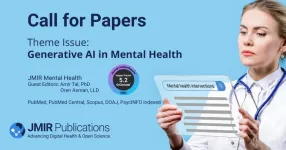(Press-News.org) Finding sustainable and clean fuels is crucial in today’s global energy and climate crisis. One promising candidate that is increasingly gaining relevance is hydrogen. However, today’s industrial hydrogen production still has a considerable CO2 footprint, especially considering processes like steam reforming or non-sustainable electrolysis.
A team led by Prof. Dominik Eder from the Institute of Materials Chemistry (TU Wien) is therefore focusing on the development of environmentally friendly processes for obtaining hydrogen, for example by photocatalysis. This process enables the conversion of water molecules to hydrogen aided by nothing but light and a catalyst. Through this process, the sun’s abundant and clean energy can be stored in the chemical bonds of this so-called solar fuel. Recently, the results have been published in the scientific journal „Advanced Energy Materials”.
Novel photocatalysts
When producing green hydrogen by photocatalysis, the catalyst plays a crucial role. In contrast to industrial catalysts, a photocatalyst utilizes the energy of light to facilitate the splitting of water at room temperature and ambient pressures. Among the most promising candidates are metal-organic frameworks, so called MOFs. They are made up of molecular inorganic building units held together by organic linker molecules. Together, they form highly porous 3D networks that have an exceptionally large surface area and excellent charge separation properties.
However, most MOFs are only active under UV light irradiation, which is why the community alters the organic compounds to make them capable of absorbing visible light. However, these modifications have a negative influence on the mobility of the electrons. Another limitation concerns charge extraction, where the electrons are released from the material: „While MOFs are indeed great at separating charge carriers at the organic-inorganic interfaces, their efficient extraction for catalytic use remains a challenge”, Dominik Eder explains.
Recently, MOFs with layered structures have caught a lot of attention for use in optoelectronic applications, as they exhibit greatly improved charge extraction properties. „You can picture these layered structures as a Manner Schnitte, where the waffle is the inorganic part and the chocolate is the organic ligand holding them together”, Pablo Ayala, lead-author of the study, illustrates. „You just need to make the waffle part conductive.”
Challenges in water splitting
In contrast to 3D-MOFs a layered MOF is usually non-porous, which reduces the catalytically active area to the external surface of the particles. „Hence, we had to find a way to make these particles as small as possible”, Eder explains. However, nanostructuring of materials is often accompanied by the introduction of structural defects. These can act as charge traps and slow down the extraction of charges. „Nobody likes a Manner Schnitte with missing chocolate”, Ayala proceeds with his comparison. "In the case of photocatalysis, we also need the best possible material that can be produced."
Therefore, Dominik Eder's team developed a new synthesis route in which even the smallest crystalline structures can be produced free of defects. This was achieved in collaboration with local and international universities. The novel, layered MOFs are based on titanium and have a cubic shape of just a few nanometers in size. The material has already been able to achieve record values in photocatalytic hydrogen production under the influence of visible light.
Aided by computer simulations carried out at Technion in Israel, the team was able to unravel the underlying reaction mechanism and demonstrated two things: First, that the layered nature of the MOF is indeed key to efficient charge separation and extraction. Second, that missing-ligand defects act as unwanted charge traps that need to be avoided as much as possible to enhance the material’s photocatalytic performance.
The research group is currently designing new layered MOFs and exploring them for various energy applications.
END
New catalysts for solar hydrogen production
2023-07-19
ELSE PRESS RELEASES FROM THIS DATE:
Acetalization: A feasible and sustainable strategy for biomass valorization
2023-07-19
Biomass, mainly composed of lignocellulose and vegetable oil, has been acclaimed as one of the most promising sustainable sources of raw carbon material for the synthesis of transport fuels and value-added chemicals. The catalytic conversion of lignocellulose/vegetable oil and their related derivatives has attracted great attention in biomass valorization. Many elegant methods including hydrolysis, dehydration, hydrogenation, hydrogenolysis, oxidation, etherification, esterification, amination, aldol condensation, ...
Collecting energy from raindrops using solar panel technology
2023-07-19
When raindrops fall from the sky, they can produce a small amount of energy that can be harvested and turned into electricity. It is a small-scale version of hydropower, which uses the kinetic energy of moving water to produce electricity. Researchers have proposed that the energy collected from raindrops could be a potential source of clean, renewable power. However, this technology has been difficult to develop on a large scale, which has limited its practical application.
To collect raindrop energy, a device called a triboelectric ...
Unraveling the molecular basis of Dmc1 filament assembly in homologous recombination
2023-07-19
Homologous recombination (HR) is an important process that plays multiple crucial roles during meiosis, a type of cell cycle dedicated to sexual reproduction. During HR, homologous DNA molecules exchange their genetic material. During the meiotic prophase, DNA are clipped throughout the genome, forming numerous DNA double-strand breaks. Such DNA breaks attract homologous recombination enzymes, which promote pairing of homologous chromosomes.
Dmc1 is one such meiosis-specific recombinase in eukaryotes (organisms that have a clearly defined nucleus), ...
Simultaneous synthesis and fixing of covalent organic frameworks
2023-07-19
Covalent organic frameworks (COFs) are versatile materials composed of interconnected organic molecules held together by covalent bonds. These frameworks can be constructed in two-dimensional or three-dimensional (3D) forms which possess a unique combination of low density, high surface area, and easily tunable properties. Among the various types of COFs, imine-linked COFs have garnered considerable attention owing to their exceptional thermal and chemical stability as well as their broad scope of monomeric starting materials.
However, traditional bulk synthetic methods for COFs often yield powders that are insoluble ...
A cool way to keep things cool: the electrocaloric effect
2023-07-19
As necessary as cooling technologies are, we’re still operating on an outdated technology that can be considered a significant contributor to global warming and greenhouse gas emissions. Currently, vapor compression cycle-based cooling (VCC) is the standard for reliable cooling of air conditioning and refrigeration, but by switching to electrocaloric cooling (EC) researchers are hoping to create a more environmentally friendly, scalable and compressor-free method of cooling to benefit businesses, families and the environment.
The researchers published their work in iEnergy on ...
JMIR Publications acquires the Online Journal of Public Health Informatics, broadening its prestigious open access portfolio
2023-07-19
(Toronto July 19, 2023) Fully open access publisher JMIR Publications has acquired the Online Journal of Public Health Informatics (OJPHI), expanding its portfolio to 35 gold open access journals. This acquisition marks an open access milestone in JMIR Publications’ continued mission to keep openness at the heart of what it does.
Indexed in PubMed Central, OJPHI has been delivering the latest developments in the emerging field of public health informatics since 2009. The journal publishes research articles, book reviews, technology reviews, working papers, interviews, commentaries, and handpicked student capstone projects.
All ...
Call for Papers: Theme Issue on “Responsible Design, Integration, and Use of Generative AI in Mental Health”
2023-07-19
JMIR Medical Education (2023 Impact Factor 5.2) and Guest Editors: Amir Tal, PhD, and Oren Asman, LLD welcome submissions to a special theme issue examining "Responsible Design, Integration, and Use of Generative AI in Mental Health"
This special theme issue aims to unite various stakeholders in exploring the responsible use of generative artificial intelligence (GAI) within the mental health domain. The goal is to curate a collection of articles that examine the advantages, challenges, and potential risks associated with deploying GAI models ...
Light quality enhances contrast vision
2023-07-19
Prof Sei-ichi Tsujimura of the Nagoya City University and Prof Su-Ling Yeh of National Taiwan University and Kagoshima University, have discovered that our visual acuity (contrast sensitivity) can be improved by using a light with a special spectrum that can selectively stimulate melanopsin cells in the retina.
Background
The retina of our eye contains cone photoreceptor cells, which identify colors in bright environment, and rod photoreceptor cells, which work in the dark. It has long been thought that humans see and identify objects by these two types of photoreceptor cells alone. ...
Monitoring often excludes crucial river ecosystems; Can citizen science fill the gap?
2023-07-19
Intermittent rivers and ephemeral streams are the world's dominant river ecosystem, yet monitoring and management typically focus on rivers that flow year round. Writing in BioScience, Amélie Truchy of the French National Research Institute for Agriculture, Food, and the Environment (INRAE) and colleagues describe the problem, as well as a potential solution: citizen science.
The authors discuss the results from a new app, DRYRivERS, which allows scientist and nonscientist users alike to record data on ephemeral streams and intermittent ...
Cardiac rehabilitation reduces risk of death years after heart surgery, still underutilized
2023-07-19
For millions of Americans who have heart surgery or experience cardiovascular complications, like heart attack or heart failure, they may be encouraged to participate in cardiac rehabilitation. The medically supervised program combines lifestyle changes, education and physical activity to help patients recover and reduce their risk of future problems.
A Michigan Medicine study now finds that people who participate in cardiac rehabilitation have a decreased risk of death years after surgery, with a trend towards better outcomes in patients who attend more sessions.
“Time and time again, cardiac rehabilitation has been shown to ...

